La Laguna Cathedral
| Cathedral of San Cristóbal de La Laguna Catedral de San Cristóbal de La Laguna (Spanish) | |
|---|---|
 | |
| Location | San Cristóbal de La Laguna, Tenerife |
| Country | Spain |
| Denomination | Roman Catholic |
| Architecture | |
| Style | Neoclassical and Neogothic |
| Groundbreaking | 1904 |
| Completed | 1915 |
The Cathedral of San Cristóbal de La Laguna or Catedral de Nuestra Señora de los Remedios (Santa Iglesia Catedral de San Cristóbal de La Laguna in Spanish) is a Catholic cathedral in Tenerife, Spain. Begun in 1904 and completed in 1915, it is dedicated to the Virgin of Los Remedios (patron of the Roman Catholic Diocese of San Cristóbal de La Laguna). This is one of the most important churches of the Canary Islands.[1]
The Cathedral of San Cristóbal de La Laguna is located in the city of San Cristóbal de La Laguna (Tenerife, Canary Islands, Spain). In the cathedral lie the remains of Alonso Fernandez de Lugo, conqueror of the island and founder of the city. The cathedral is located in the historic center of the city of La Laguna, and was declared a World Heritage Site in 1999 by UNESCO. The cathedral contains elements of several architectural styles including Neoclassical and Neo-Gothic. The most representative elements of the Cathedral of La Laguna are its Neoclassical facade, inspired by the Cathedral of Pamplona, and the dome, which stands out prominently in the city landscape.
History
Primitive temples
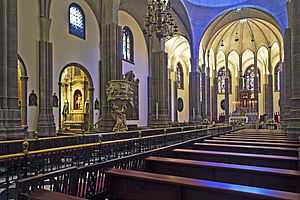
In 1511 a hermitage was built on the site of the current building (Plaza de Fray Albino). It was built by order of the conqueror of the island, Alonso Fernández de Lugo. There are indications that there was a Guanche necropolis. It is also known that the whole valley of Aguere (in which the city lies), especially the large lake that was in this place, was a place of pilgrimage for the indigenous people of the island.[2]
This primitive chapel was originally dedicated to the Virgin Mary in her Expectation, which is celebrated every December 18.[3]
The chapel was replaced in 1515 with a major construction dedicated to the Virgin of Los Remedios in the Mudejar style, to which a tower was added in 1618. It was on April 21, 1515, when the site rose to the level of parish with the name "Santa Maria de los Remedios".[4] The feast day of the Nativity of the Virgin Mary is celebrated on September 8.
That same year, the Portuguese mason Miguel Alonso built the main chapel, the main arch, the altar, the stands, the tabernacle and the door of the sacristy, all made of stone.
On April 7, 1534, Saint José de Anchieta was baptized in the church. He was born in the city of La Laguna, became a missionary, and later became the founder of the city of Sao Paulo and one of the founders of Rio de Janeiro, both in Brazil.[5]
In 1752 a new transept was built, the main chapel vestries were widened and spacious dressing rooms were added for the image of the patron saint, the Virgen de los Remedios. Don Domingo de la Guerra, who directed the work and was later Marqués de San Andrés, extended the main chapel, because he hoped that one day the temple would become the Cathedral of Tenerife.[6]
Cathedral
Several times since the old chapel was converted into a parish in 1515, there were attempts to have it be designated a cathedral, collegiate, or auxiliary cathedral dependent on the Cathedral of Santa Ana of Las Palmas de Gran Canaria, with some of the members of the Canary Cathedral Chapter residing in the Church of Los Remedios. These initial applications were not successful.[7]
In 1783, at the height of the Enlightenment (La Laguna was the center of this movement in the Canary Islands), a request was made for designation as a diocese to be located in the Church of Los Remedios[8] but the request was received with suspicion by members of the Cathedral Chapter and the Bishop of Gran Canaria, and the establishment of an ecclesiastical institution on this island was again rejected.[9]
Finally, on February 1, 1818, a papal bull approved the division of the Roman Catholic Diocese of Canarias in two dioceses.[10] The temple became a cathedral in 1819 by bull of Pope Pius VII, and the new diocese of La Laguna was created.[11]
At the time the building was constructed and dedicated as a cathedral, the capital of the island was the city of San Cristóbal de La Laguna, which is why the cathedral was built there and not in the current capital of the island (Santa Cruz de Tenerife). The diocesan headquarters still remains in San Cristóbal de La Laguna. On October 5, 1983, the Cathedral of La Laguna was declared a National Historic-Artistic Monument in Spain.
The cathedral is also a parish and a Marian shrine, as the Virgin of Los Remedios is the patron saint of the Roman Catholic Diocese of San Cristóbal de La Laguna. There is some expectation that this church will be declared a minor basilica by the Holy See in the near future.
Restoration 2002–2014
In 2002 the cathedral was closed to worship for a meticulous restoration, with the intention of reopening a few years later. However, due to bureaucratic disagreements, the cathedral remained closed for more than a decade. During the pre-restoration study, it had been discovered that the main dome and vaults were so damaged that the only viable solution was the demolition of these elements and their subsequent reconstruction. The new vaults and domes were built with a new material, polypropylene fiber, making the cathedral the first in the world to use this material. Finally, the doors were reopened on January 25, 2014, to be reopened to worship on January 31 of that year.
To mark the centenary and the reopening of the cathedral, a Jubilee Year was held[12] from April 27, 2014, until April 12, 2015, both dates coinciding with the Divine Mercy Sunday. That Jubilee was decreed by a special mandate of Pope Francis, with the chance of winning the faithful a plenary indulgence.[13]
During the remodeling, which included Cathedral Square in 2014, archaeological remains were discovered underground. Some evidence was unearthed in the rubble that suggested it belonged to the ancient Church of Los Remedios or to structures from the first European settlement in the city.[14]
Architecture
The Neoclassical front dates back to 1820. The current building was constructed between 1904 and 1915 and is in the Neo-Gothic style. The cathedral has three wide aisles and an ambulatory (unique in the Canary Islands) that surrounds the chancel, or altar. These elements give the interior of the cathedral a typical medieval European feel in contrast to the colonial style of the exterior.
The cathedral's large dome is topped by a large concrete cross. It is 41.5 m (136 ft) in height, which makes it the highest point in the old town. The vaults are topped by small windows that let in natural light. The dome is covered with copper plates, imitating the cathedrals of central and northern Europe.
Chapels of the cathedral
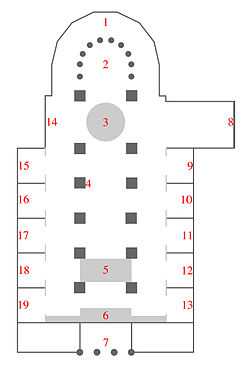
1- Ambulatory
2- High altar
3- Dome
4- Pulpit
5- Stalls of Cathedral Chapter
6- Organ loft
7- Portal
8- Chapel of Our Lady of Remedies
9- Chapel of the Immaculate Conception
10- Chapel of Saint Teresa of Avila
11- Side entrance on the street Obispo Rey Redondo (Calle de La Carrera)
12- Chapel of Our Lady of Mount Carmel
13- Chapel of Saint Barbara
14- Table of Souls in Purgatory
15- Chapel of Christ tied to the Column
16- Chapel of Our Lady of Candelaria
17- Side entrance down the street Bencomo
18- Chapel of Saint Joseph of Nazareth
19- Chapel of the Baptistery
Chapel of Saint Teresa of Avila
The altarpiece of Saint Teresa of Avila is Neo-Gothic. In the center is the statue of St. Teresa of Avila. The chapel also is the altarpiece of Ecce Homo (locally called "Señor de la Cañita") that was installed in March 2014, shortly after the reopening of the cathedral following its recent restoration.
-

Altarpiece of Saint Teresa of Avila
-

Saint Teresa of Avila
-
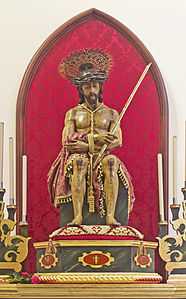
Señor de la Cañita
Chapel of the Immaculate Conception
This chapel, dedicated to the Immaculate Conception, is located on the right side (side of the Epistle) directly next to the Chapel of Our Lady of Remedies. The altarpiece of the Immaculate was created in 1915 and suffered extensive damage during the time the cathedral was closed for restoration from 2002–2014. Today, the altarpiece of the Immaculate is awaiting restoration. The sculpture of the Our Lady of Light (Nuestra Señora de la Luz) is in this chapel, dating from the mid-sixteenth century. The tomb of bishop Nicolás Rey Redondo is in the back of the chapel.
-

Nuestra Señora de la Luz
-
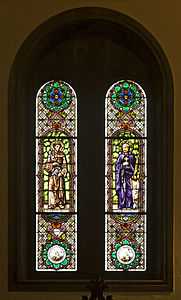
Stained glass windows depicting Saint Diego de Alcalá and Blessed Ignacio de Azevedo
Chapel of Christ tied to the Column
The sculpture of Christ at the column that presides over this chapel was blessed on June 6, 1756, and was created by sculptor Pietro Galleano in Genoa (Italy). The altarpiece was carved between 1763 and 1765, and is covered in gold. Next to Christ is the statue of Our Lady of Sorrows carved in Seville and attributed to the sculptor Gabriel Astorga y Miranda, and the other side is Saint Mary Magdalene.
-
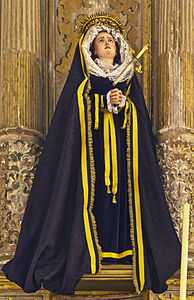
Our Lady of Sorrows
-

Christ at the column
-
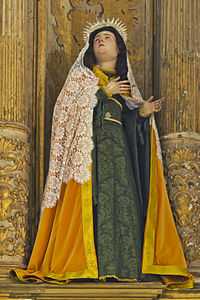
Saint Mary Magdalene
Chapel of Our Lady of Candelaria
The altarpiece of the Virgin of Candelaria was initially dedicated to the Virgin of Mercy. The sculpture of the Virgin of Candelaria is a replica of the patron saint of the Canary Islands venerated in the Shrine Basilica of the town of Candelaria. This image was made by local sculptor Faustino Álvarez Hernández and restored by sculptor Ezequiel de León Domínguez. Next to the Virgin are some sculptures of Saint José de Anchieta and the Sacred Heart of Jesus. In the chapel there is also a sculpture of Christ Nazarene which came from Valencia and reached the city of La Laguna in 1901.
-
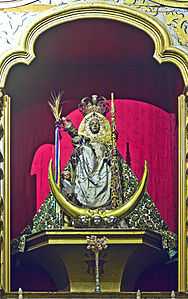
Virgin of Candelaria
-
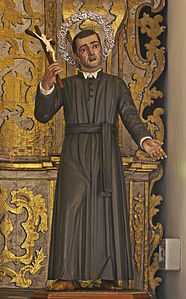
Saint José de Anchieta
-
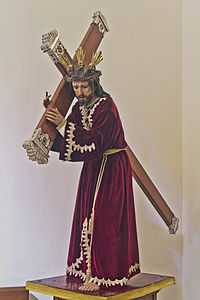
Christ Nazarene
Chapel of Saint Joseph of Nazareth
The image of Saint Joseph of Nazareth is dressed in rich robes of cloth and dates from the late seventeenth century by Lázaro González de Ocampo. The figure of the Child Jesus is from a later period. There are also sculptures of Saint Anne and Saint Joachim, which are considered masterpieces of eighteenth century Canarian art. At the top of the altar is a small wooden statue of Saint Jerome.
-
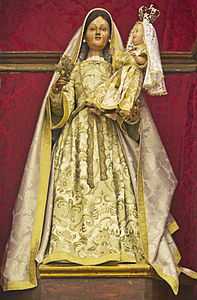
Saint Anne
-
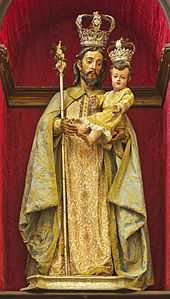
Saint Joseph of Nazareth
-
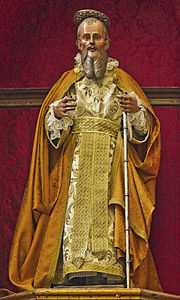
Saint Joachim
Chapel of Saint Barbara
The altarpiece of Saint Barbara is neo-Gothic. It was designed by Francisco Bonnin Guerin and created by members of the artillery corps de Santa Cruz de Tenerife. This altarpiece was initially in the Church of Saint Francis of Assisi in Santa Cruz de Tenerife. Also in this chapel is the altarpiece of Our Lady of La Salette donated by Estanislada González in 1915.
-
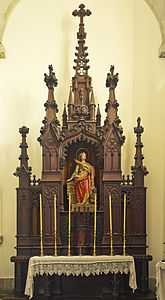
Neo-Gothic altarpiece of Saint Barbara
-
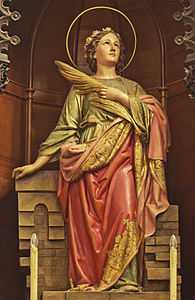
Sculpture of Saint
-

Altarpiece of Our Lady of La Salette
Chapel of Our Lady of Mount Carmel
The altarpiece of the Our Lady of Mount Carmel is another neo-Gothic altarpiece. In the center is the image of the Virgin of Mount Carmel dressed in baroque style, which has been in the cathedral since 1619. In the lateral niches are sculptures of Saint Andrew the Apostle and Saint Therese of Lisieux. On one side is the image of Christ of Burgos. The original sculpture of the Christ who was venerated in the city was destroyed in 1964 due to a fire in the Convent of San Agustín where his statue had been.
-
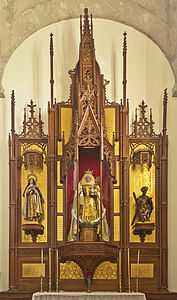
Altarpiece of the Our Lady of Mount Carmel
-

Saint Andrew the Apostle
-

Christ of Burgos
Chapel of the Baptistery
Most of this chapel is occupied by a Baptismal font of 1969. Also in this chapel is the altarpiece of Saint Thomas Aquinas where is the statue of the saint. Next to it is the image of the Virgin of Mercy, which was created by sculptor José Rodríguez de la Oliva. Another image that is in this chapel is Saint Lawrence of Rome, probably dating from the second half of the seventeenth century.
-
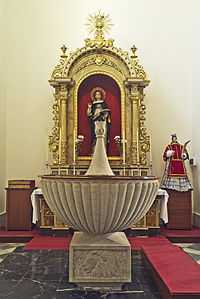
Altarpiece of Saint Thomas Aquinas and baptismal font
-

Virgin of Mercy
-
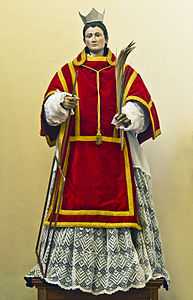
Saint Lawrence of Rome
Chapel of Our Lady of Remedies

The highlight of the interior of the cathedral is the altarpiece of Our Lady of Remedies, patron saint of the city of San Cristóbal de La Laguna, of the island of Tenerife and the Roman Catholic Diocese of San Cristóbal de La Laguna and of the Marian devotion to which the cathedral is consecrated. Her feast is celebrated on September 8.
The altarpiece of the Our Lady of Remedies is in a chapel in the transept of the cathedral and is the largest altarpiece in the Canary Islands. It is a great Baroque altarpiece from the first half of the eighteenth century, with an impressive set of seven panels attributed to Hendrick Van Balen, Van Dyck's teacher. The image of the Virgin of Los Remedios is located in the central niche and is adorned in rich robes and dresses. It is located in a spectacular canopy over a silver throne, with a sunburst of the same framing material and a golden crescent moon at her feet.
Other artworks
Inside there is a pulpit of Carraran Italian marble carved by Pasquale Bocciardo, and part of Mazuelos's Altarpiece. In addition, there are valuable works by Cristóbal Hernández de Quintana, Luján Pérez and Fernando Estévez.
Also inside the cathedral is the image of Christ of Los Remedios, which is considered the twin of Cristo de La Laguna. This image is located on the marble tabernacle of the main altar. The image dates from the sixteenth century and is by an unknown artist. The temple also houses a large canvas with the theme The Souls of Purgatory by the painter Cristóbal Hernández de Quintana, and a painting of the Last Supper, the work of Juan de Miranda.
Inside the cathedral the relics of the martyrs are preserved: San Aurelio de Córdoba, San Faustino, San Venusto and San Amado Nusco, plus a piece of the mantle of San Fernando and a bone of James the Less. But the most important relics of the cathedral are the two saints of the Canary Islands, Peter of Saint Joseph Betancur and José de Anchieta.
Chapter house and Icons museum
The Chapter house is home to the Cathedral Chapter, also called the Chapter of Canons, which constitutes the corporation of priests responsible to serve in cult of the Cathedral and its religious and cultural activities. The building is a well-known Canarian house of the eighteenth century, attached to the building of the cathedral.
It houses the Icons museum, which contains the largest collection of Byzantine icons of Spain,[15] with 160 original pieces that are mostly about 300 years old. These artworks are owned by the Diocese of Tenerife and come mainly from countries such as Russia, Romania, Yugoslavia, Italy and Greece.[16] These pieces came to Tenerife through private donations to the bishopric and through merchants who arrived in the Canary Islands.
The La Laguna Cathedral is one of the few Catholic cathedrals in the world with a museum dedicated to Orthodox art.[17]
Gallery
-

Baroque altarpiece of the Virgin of the Remedies
-

Tomb of Alonso Fernández de Lugo, conqueror of the island and city founder
-

Choir
-

Marble pulpit designed by Pasquale Bocciardo
-

Tabernacle of the main altar
-

Table of Souls in Purgatory
See also
- Roman Catholic Diocese of San Cristóbal de La Laguna
- Real Santuario del Santísimo Cristo de La Laguna
- Basilica of Candelaria
- San Cristóbal de La Laguna
References
| Wikimedia Commons has media related to Catedral de Nuestra Señora de los Remedios (San Cristóbal de La Laguna). |
- ↑ Historia de la Diócesis Nivariense – in Spanish
- ↑ La Laguna. La ciudad de los sentidos
- ↑ Datos historicos del templo catedral de Tenerife
- ↑ Datos historicos del templo catedral de Tenerife
- ↑ La Catedral custodia una reliquia de Anchieta
- ↑ Datos historicos del templo catedral de Tenerife
- ↑ Programa de la Semana Santa de La Laguna 2014
- ↑ Programa de la Semana Santa de La Laguna 2014
- ↑ La Diócesis de San Cristóbal de La Laguna en los inicios del siglo XIX: el Obispo Folgueras Sión, el Cabildo Catedral y la jurisdicción eclesiástica
- ↑ La Diócesis de San Cristóbal de La Laguna en los inicios del siglo XIX: el Obispo Folgueras Sión, el Cabildo Catedral y la jurisdicción eclesiástica
- ↑ La Diócesis de San Cristóbal de La Laguna en los inicios del siglo XIX: el Obispo Folgueras Sión, el Cabildo Catedral y la jurisdicción eclesiástica
- ↑ Año jubilar con ocasión del Centenario de la Catedral de la Laguna y su reapertura al culto
- ↑ Año jubilar con ocasión del Centenario de la Catedral de la Laguna y su reapertura al culto
- ↑ El Ayuntamiento contrata un estudio de la plaza de la Catedral con georradares
- ↑ La mayor colección española de iconos bizantinos se exhibe en La Laguna
- ↑ La mayor colección española de iconos bizantinos se exhibe en La Laguna
- ↑ La mayor colección española de iconos bizantinos se exhibe en La Laguna
Coordinates: 28°29′20″N 16°18′59″W / 28.48889°N 16.31639°W
| |||||||||||||||||||||||||||||||||||||||||||||||||||||||||||||||||
